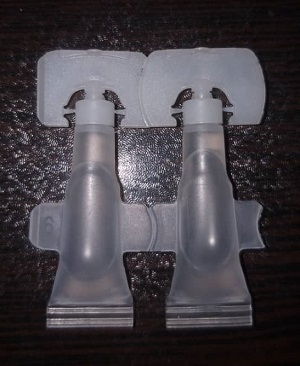A Pilot Study of the Short Term Effectiveness and Safety of Amniotic Fluid in Severe Dry Eye Disease
Medical hypothesis discovery and innovation in ophthalmology,
Vol. 8 No. 2 (2019),
15 June 2019
,
Page 81-84
Abstract
The aim of this study was to evaluate if amniotic fluid (AF) mixed with artificial tears or soaked with a soft contact lens (SCL) as a treatment for severe dry eye disease (DED) would improve its signs or symptoms. In this retrospective pilot study 22 consecutive eyes of 11 patients with level 3 DED classified by DEWS 1 (Dry Eye WorkShop 1 2007), were included in the study between June 1 and September 30 in 2017. The study was conducted before DEWS II (Dry Eye WorkShop II 2017), which was published in October 2017. Therefore, DEWS II was not adopted for this study. Soft Contact Lens Acuvue Oasys of Plano with 8.8 base curve and 14 mm diameters by Johnson and Johnson were used to soak in FloGraft, which is an AF, for 30 minutes before placing in 12 eyes in Group 1. The contact lenses were placed in the left eye for 1 week. In Group 2, 10 eyes used 6 mL of artificial tears mixed with 0.25 mL of AF, which were applied to the eye four times a day for 1 week. No other eye medications were used. The eyes that were included had diffuse punctate staining and fast tear breaking times of <5 seconds with severe ocular symptoms (DEWS 1 level 3-4). Photos of fluorescein stain corneas before the treatment and 1 week after the treatment were used to compare the distribution of punctate staining as the objective outcomes for signs. Several questions adopted from the Ocular Surface disease Index (OSDI) about subjective symptoms before and after the treatment were asked, and documented on the chart. Improvement either in symptoms or signs or both of DED after 1 week at follow-up examination was recorded. Group 1, with SCL 46% had improvement after 1 week and Group 2, with artificial tears 50% had improvement after 1 week. Improvement means either symptom relief or comparatively decreased distribution of punctate staining on the cornea or both. No cases had inflammation, infection, irritation or blurred vision. We concluded that FloGraft as an AF can safely improve the symptoms or the signs of severe DED either as a mix with artificial tears or soaked with SCL by about 50% in this case series without evidence of irritation, inflammation or blurred vision in the short term.
References
Moss SE, Klein R, Klein BE. Prevalence of and risk factors for dry eye syndrome. Arch Ophthalmol. 2000;118(9):1264-8. pmid: 10980773
International Dry Eye WorkShop. Membership of the International Dry Eye WorkShop (DEWS). DEWS I, 2007 15420124 Contract No.: 2.
Geerling G, Maclennan S, Hartwig D. Autologous serum eye drops for ocular surface disorders. Br J Ophthalmol. 2004;88(11):1467-74. doi: 10.1136/bjo.2004.044347 pmid: 15489495
Ervin AM, Law A, Pucker AD. Punctal occlusion for dry eye syndrome: summary of a Cochrane systematic review. Br J Ophthalmol. 2019;103(3):301-6. doi: 10.1136/bjophthalmol-2018-313267 pmid: 30337332
Pachigolla G, Prasher P, Di Pascuale MA, McCulley JP, McHenry JG, Mootha VV. Evaluation of the role of ProKera in the management of ocular surface and orbital disorders. Eye Contact Lens. 2009;35(4):172-5. doi: 10.1097/ICL.0b013e3181a66a12 pmid: 19474753
Underwood MA, Gilbert WM, Sherman MP. Amniotic fluid: not just fetal urine anymore. J Perinatol. 2005;25(5):341-8. doi: 10.1038/sj.jp.7211290 pmid: 15861199
Rennie K, Gruslin A, Hengstschlager M, Pei D, Cai J, Nikaido T, et al. Applications of amniotic membrane and fluid in stem cell biology and regenerative medicine. Stem Cells Int. 2012;2012:721538. doi: 10.1155/2012/721538 pmid: 23093978
Hamid AA, Joharry MK, Mun-Fun H, Hamzah SN, Rejali Z, Yazid MN, et al. Highly potent stem cells from full-term amniotic fluid: A realistic perspective. Reprod Biol. 2017;17(1):9-18. doi: 10.1016/j.repbio.2017.02.001 pmid: 28262444
Karacal N, Kosucu P, Cobanglu U, Kutlu N. Effect of human amniotic fluid on bone healing. J Surg Res. 2005;129(2):283-7. doi: 10.1016/j.jss.2005.03.026 pmid: 15916770
Nyman E, Huss F, Nyman T, Junker J, Kratz G. Hyaluronic acid, an important factor in the wound healing properties of amniotic fluid: in vitro studies of re-epithelialisation in human skin wounds. J Plast Surg Hand Surg. 2013;47(2):89-92. doi: 10.3109/2000656X.2012.733169 pmid: 23356944
Ozgenel GY, Samli B, Ozcan M. Effects of human amniotic fluid on peritendinous adhesion formation and tendon healing after flexor tendon surgery in rabbits. J Hand Surg Am. 2001;26(2):332-9. doi: 10.1053/jhsu.2001.22524 pmid: 11279581
Murri MS, Moshirfar M, Birdsong OC, Ronquillo YC, Ding Y, Hoopes PC. Amniotic membrane extract and eye drops: a review of literature and clinical application. Clin Ophthalmol. 2018;12:1105-12. doi: 10.2147/OPTH.S165553 pmid: 29950805
Royan Institute. The Improvement of Limbal Stem Cell Deficiency (LSCD) in Unilateral Stem Cell Damage by Amniotic Membrane Extract Eye Drop (AMEED) Iran: Royan Institute; 2018 [updated 2018; cited 2018 May 1]. Available from: https://www.clinicaltrials.Gov/ct2/show/NCT02649621cond=amniotic+membrane+extract&rank=2.
Royan Institute. Utilization of Amniotic Membrane Extract Eye Drop (AMEED) on Human Corneal Healing Iran: Royan Institute; 2018 [updated 2018; cited 2018 May 1]. Available from: https://www.clinicaltrials.gov/ct2/show/NCT02746848?cond=amniotic+membrane+extract&rank=1.
Shayan Asl N, Nejat F, Mohammadi P, Nekoukar A, Hesam S, Ebrahimi M, et al. Amniotic Membrane Extract Eye Drop Promotes Limbal Stem Cell Proliferation and Corneal Epithelium Healing. Cell J. 2019;20(4):459-68. doi: 10.22074/cellj.2019.5423 pmid: 30123991
McDonald MB, Sheha H, Tighe S, Janik SB, Bowden FW, Chokshi AR, et al. Treatment outcomes in the DRy Eye Amniotic Membrane (DREAM) study. Clin Ophthalmol. 2018;12:677-81. doi: 10.2147/OPTH.S162203 pmid: 29670328
- Abstract Viewed: 1335 times
- Free Full Text PDF Downloaded: 759 times


